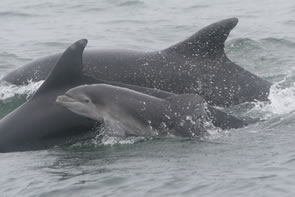Species Index


What is a Cetacean?
Whales, dolphins and porpoises belong to a single group of marine mammals called the cetaceans (order Cetacea). The word cetacean comes from the Latin ‘cetus’ meaning large sea creature, and the ancient Greek ‘ketos’ meaning sea monster. Cetaceans are marine mammals that evolved from their land mammal ancestors around 55 - 60 million years ago and have adapted perfectly to an aquatic life during this time. There are currently about 83 species of whale, dolphin and porpoise in the world, but new species are still being discovered; 24 of these have been recorded in the waters off western Scotland.
Cetaceans are mammals that are insulated by a thick layer of blubber (fat) in order to maintain a body temperature of about 37°C. They surface to breathe air through their blowholes, which close automatically below water. Most species have a dorsal (back) fin, ranging from a small bump on a sperm whale to a tall killer whale fin; all species have two pectoral (side) fins and a fluke (tail).
Cetaceans are divided into two groups:
Odontocetes – the toothed cetaceans, containing about 70 species of whale, dolphin and porpoise. As well as teeth, all species have a single blowhole. Odontocetes use echolocation to find food and to navigate. The most numerous family is the Delphinidae, which includes all of the oceanic dolphins.
Mysticetes – the baleen cetaceans, containing about 13 species. Instead of teeth, all species have baleen plates growing from their upper jaw which sieve prey such as small schooling fish and plankton from the water. Baleen is made from keratin, the same substance as human hair and fingernails. Mysticetes have two blowholes and are not known to echolocate.
Cetaceans and Sound
Sound is very important to all cetaceans: they have sensitive hearing and use a range of sounds to communicate, to locate food, to avoid predators and to navigate. Vocalisations can be divided into two types:
1. Tonal calls, such as whistles, ‘whale song’ and groans are used chiefly for communication,
2. Clicks, either singular or in bursts, are mainly used to explore the environment and find food.
Many cetaceans are highly vocal and produce sound to communicate with one another. These sounds range from simple calls to keep a group together or to display aggression, to more complex repertoires displayed during breeding seasons, such as the humpback whale ‘song’. Odontocetes have developed sophisticated echolocation systems, where sound emitted in a directional beam hits an object and the ‘echo’ that returns allows the cetacean to locate, identify and range the object. Researchers onboard Silurian can listen to and record the sounds made by cetaceans; this means that animals can be detected which are not visible, either because they are underwater, or because the environmental conditions, such as a rough sea, make it hard to see them.
Migration
All cetaceans make daily movements in order to find food. Some of the species seen in the Hebrides, including the bottlenose dolphin and the harbour porpoise, are believed to be resident all year round and occupy a range along the west coast of Scotland. Others make seasonal migrations between warm water breeding grounds and cold water feeding grounds. Minke whales and common dolphins, amongst other species, are frequently seen off western Scotland between May and September taking advantage of the abundant fish. Occasionally humpback whales are seen in Hebridean waters; these whales are known to make one of the longest seasonal migrations between breeding grounds off Africa to feeding grounds around Iceland and Norway.
Reproduction
As mammals, cetaceans give birth to live young following a gestation period of between 8 and 16 months. A single calf is born tail first and must be lifted to the surface by its mother to breathe. Cetaceans are social animals and other females may offer assistance in lifting, protecting and even feeding newborn calves. Feeding on a fat-rich, nutritious milk, growth is very fast. For example, a newborn blue whale consumes more than 100 litres of milk per day and grows from roughly seven metres at birth to 15 metres at seven months of age. Calves stay close to their mothers, and will suckle for anywhere between several months to several years, depending on the species and the environmental circumstances. For cetaceans in general, low reproductive rates are offset by relatively long life spans and high survivorship of calves due to intensive parental care.
Life in the Ocean
Cetaceans are well-adapted to a life beneath the waves having evolved for millions of years from land mammal ancestors. The body is streamlined to reduce drag and energy usage; external features including the ears and reproductive organs are tucked inside the body behind slits; cetaceans have no hind limbs although some vestigial bone fragments of the pelvis and legs can remain. Unlike land mammals, cetaceans have do not have hair (although some species may have a couple of facial whiskers) or fur coats because this would further increase drag. They are instead covered in a thick layer of blubber to keep them warm in the cold sea. Their fore-flippers have a bone structure similar to a human hand, but bones are elongated and webbed with skin to help with swimming. The dorsal fin aids stability in the water and the tail provides powerful propulsion by beating up and down. The nasal openings have migrated to the top of the head to form one or two blowholes to make it easier to breathe at the surface.
Cetaceans are able to dive to great depths for extended periods to hunt for food. Sperm whales can dive to depths of 2500 metres for up to two hours. They are able to store huge amounts of oxygen in their blood and muscles, and divert oxygen to the brain and heart. The lungs actually collapse under great pressure during a deep dive; some whales are thought to suffer from ‘the bends’ (decompression illness) if they surface too rapidly.





